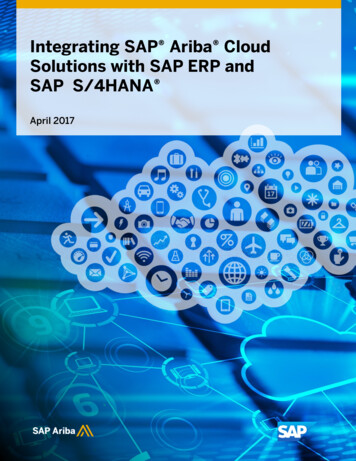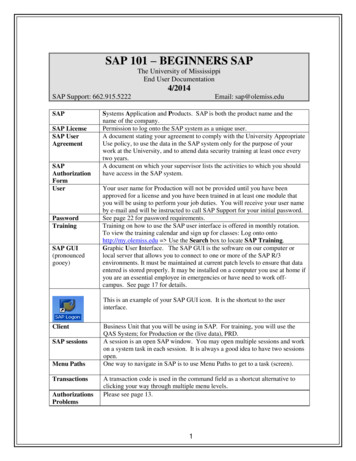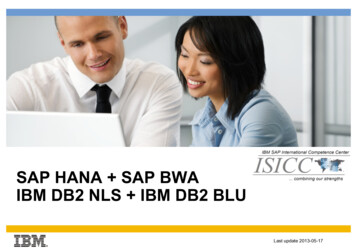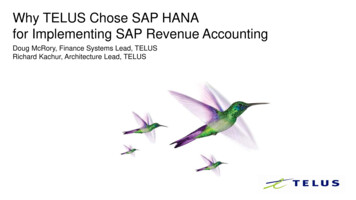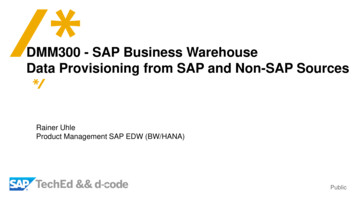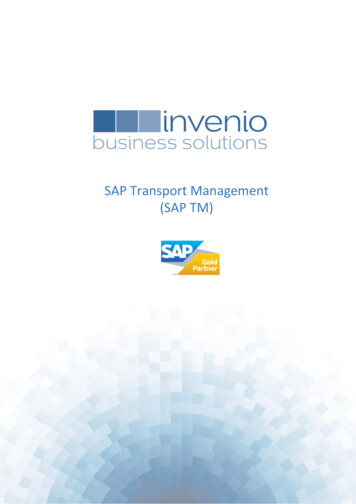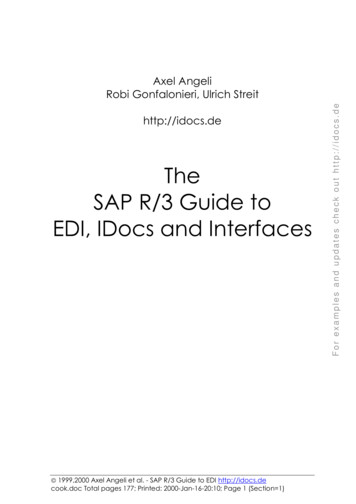
Transcription
http://idocs.deTheSAP R/3 Guide toEDI, IDocs and Interfaces 1999,2000 Axel Angeli et al. - SAP R/3 Guide to EDI http://idocs.decook.doc Total pages 177; Printed: 2000-Jan-16-20:10; Page 1 (Section 1)For examples and updates check out http://idocs.deAxel AngeliRobi Gonfalonieri, Ulrich Streit
About The AuthorsAxel Angeli,including German, English, French and Slavic.! axela@logosworld.deRobi Gonfalonieri,born in 1965 is a senior ABAP IV developer and R/3 consultant for SD and MM. Heis a learned economist turned ABAP IV developer. He specializes in international,multi-language projects both as developer and SD consultant. He speaks fluentlyseveral languages including German, French, English and Italian.! robig@logosworld.deUlrich Streit,born in 1975 is ABAP IV developer and interface specialist. He developed aserious of legacy system interfaces and interface monitors for several clients of theprocess industry.! ulis@logosworld.delogosworld.comis a group of loosely related freelance R/3 consultants and consulting companies.Current members of the logosworld.com bond are the following fine companies: Logos! Informatik GmbH, Brühl, Germany: R/3 technical troubleshooting OSCo GmbH, Mannheim, Germany: SAP R/3 implementation partner UNILAN Corp., Texas: ORACLE implementation competenceFor true international R/3 competence andenthusiastic consultants,email us ! info@logosworld.deor visit http://idocs.de 1999 Axel Angeli et al. - SAP R/3 Guide to EDI, IDocs and ALEFor examples and updates check out http://idocs.deis born in 1961. He is a Top Level SAP R/3 consultant and R/3 cross-applicationdevelopment coach. He specializes in coaching of large multi-national, multilanguage development teams and troubleshooting development projects.His job description is also known as computer logistics, a delicate discipline thatmethodically wakes the synergetic effects in team to accelerate and mediate ITprojects.He is a learned Cybernetics scientist (also known as Artificial Intelligence) in thetradition of the Marvin Minsky [The society of mind] and Synergetics group ofHerman Haken and Maria Krell. His competence in computer science is based onthe works of Donald Knuth [The Art of Computer Programming], Niklas Wirth (thecreator of the PASCAL language), the object oriented approach as describedand developed during the XEROX PARC project (where the mouse and windowsstyle GUIs have been invented in the early 1970ies) and Borland languages.Before his life as SAP consultant, he made a living as a computer scientist formedical biometry and specialist for high precision industry robots. He concentratesnow on big international projects. He speaks fluently several popular languages
For Doris, Paul, Mini 1999 Axel Angeli et al. - SAP R/3 Guide to EDI, IDocs and ALEcook.doc Total pages 177; Print date: 16.01.00; Page ii
Danke, Thank You, Graçias,Tack så mycket, Merci, Bedankt,Grazie, Danjawad, Nandri, Se-SeI due special thanks to a variety of people, clients, partners and friends. Theirinsistence in finding a solution and their way to ask the right questions made thisbook only possible.Thanks to Detlef and Ingolf Streit for doing the great cartoons.Thanks also to Pete Kellogg of UNILAN Corp., Texas, Juergen Olbricht, WolfgangSeehaus and his team of OSCo, Mannheim for continuously forming such perfectproject teams. It is joy working with them.Plans are fundamentally ineffective because the "circumstances of our actions arenever fully anticipated and are continuously changing around us". Suchman does notdeny the existence or use of plans but implies that deciding what to do next in thepursuit of some goal is a far more dynamic and context-dependent activity thanthe traditional notion of planning might suggest.Wendy Suchman, Xerox PARC http://innovate.bt.com/showcase/wearables/ 1999 Axel Angeli et al. - SAP R/3 Guide to EDI, IDocs and ALEFor examples and updates check out http://idocs.deI want especially honour Francis Bettendorf, who has been exactly that genre ofknowledgeable and experienced IT professionals I had in mind, when writing thisbook. A man who understands an algorithm when he sees it and without beingtoo proud to ask precise and well-prepared questions. He used to see me everyday with the same phrase on the lips: "Every day one question." He heavilyinfluenced my writing style, when I tried to write down the answers to his questions.He also often gave the pulse to write down the answers at all. At the age of 52, hejoyfully left work the evening of Tuesday the 23rd March 1999 after I had anotherfruitful discussion with him. He entered immortality the following Wednesdaymorning. We will all keep his memory in our heart.
Who Would Read This Book?This book was written for the experienced R/3 consultants, who wants to knowmore about interface programming and data migration. It is mainly a compilationof scripts and answers who arose during my daily work as an R/3 coach.The R/3 Guide is a Frequently Given Answers book. It is acollection of answers, I have given to questions regarding EDIover and over again, both from developers, consultants andclient’s technical staff. It is focussed on the technical aspect ofSAP R/3 IDoc technology. It is not a tutorial, but a supplementto the R/3 documentation and training courses.Quis – Who shouldread the book?The R/3 Guide has been written with the experiencedconsultant or ABAP developer in mind. It does not expect anyspecial knowledge about EDI, however, you should be familiarwith ABAP IV and the R/3 repository.Quo modo – howWell, this book is a “How to” book, or a “Know-how”-book. Thedo you benefit from R/3 Guide has its value as a compendium. It is not a novel tothe book?read at a stretch but a book, where you search the answerwhen you have a question.Quo (Ubi) – Wherewould you use thebook?You would most likely use the book when being in a projectinvolved in data interfaces, not necessarily a clean EDI project.IDocs are also helpful in data migration.Quando – whenThe R/3 Guide is not a tutorial. You should be familiar with theshould you read the general concept of IDocs and it is meant to be used after youbookhave attended an R/3 course on IDocs, ALE or similar. Insteadof attending the course you may alternatively read one of theR/3 IDoc tutorial on the market.Cur – Why shouldyou read the bookBecause you always wanted to know the technical aspects ofIDoc development, which you cannot find in any of thepublicly accessible R/3 documentation. 1999,2000 Axel Angeli et al. - SAP R/3 Guide to EDI http://idocs.decook.doc Total pages 177; Printed: 2000-Jan-16-20:10; Page 5 (Section 3)For examples and updates check out http://idocs.deQuid – What is thatbook about?
Table Of ContentsWhere Has the Money Gone?11.1Communication. 2More than 80% of the time of an EDI project is lost in waiting for answers,trying to understand proposals and retrieving data nobody actually needs.1.2Psychology of Communication. 3Bringing developers together accelerates every project. Especially whenboth parties are so much dependent on each other as in an EDI project, thepartners need to communicate without pause.1.35Marcus T. Cicero. 6Some may have learned it in school: the basic rules of rhetoric according toCicero. You will know the answers, when your program is at its end. Whydon’t you ask the questions in the beginning? Ask the right question, thenyou will know.6What Are SAP R/3 IDocs?72.1What are IDocs? . 8IDocs are structured ASCII files (or a virtual equivalent). They are the fileformat used by SAP R/3 to exchange data with foreign systems.2.28Exploring a Typical Scenario . 9The IDoc process is a straight forward communication scenario. Acommunication is requested, then data is retrieved, wrapped and sent tothe destination in a predefined format and envelope.9Get a Feeling for IDocsFehler! Textmarke nicht definiert.Fehler!Textmarke nicht definiert.3.1Get A Feeling For IDocs .For the beginning we want to give you a feeling of what IDocs are and howthey may look like, when you receive it as a plain text file.Fehler! Textmarke nicht definiert.3.2The IDoc Control Record. Fehler! Textmarke nicht definiert.3.3The IDoc Data . Fehler! Textmarke nicht definiert.The very first record of an IDoc package is always a control record. Thestructure of this control record is the DDic structure EDIDC and describes thecontents of the data contained in the package. Fehler! Textmarke nicht definiert.For examples and updates check out http://idocs.de5Who Is on Duty? . 5Writing interface programs is much like translating languages. The same ruleapply.1.64Strategy . 5Do not loose your time in plans. Have prototypes developed and take themas a basis.1.53Phantom SAP Standards and a Calculation. 4It is reported that SAP R/3 delivers standard EDI programs and that theyshould not be manipulated and no circumstances. Because this is not true,much project is lost in chasing the phantom.1.42All records in the IDoc, which come after the control record are the IDocdata. They are all structured alike, with a segment information part and adata part which is 1000 character in length, filling the rest of the line.Fehler! Textmarke nicht definiert. 1999,2000 Axel Angeli et al. - SAP R/3 Guide to EDI http://idocs.decook.doc Total pages 177; Printed: 2000-Jan-16-20:10; Page i (Section 4)
iiContents3.4Interpreting An IDoc Segment Info . Fehler! Textmarke nicht definiert.All IDoc data records are exchanged in a fixed format, regardless of thesegment type. The segment’s true structure is stored in R/3’s repository as aFehler! Textmarke nicht definiert.DDic structure of the same name.3.5IDoc Base - Database Tables Used to Store IDocs . Fehler! Textmarke nichtdefiniert.When R/3 processes an IDoc via the standard inbound or outboundmechanism, the IDoc is stored in the tables. The control record goes to tableFehler! Textmarke nicht definiert.EDIDC and the data goes to table EDID4.Exercise: Setting Up IDocs194.1Quickly Setting up an Example .20If you have a naked system, you cannot send IDocs immediately. Thischapter will guide you through the minimum steps to see how the IDocengine works.4.2Example: The IDoc Type MATMAS01 .21To sharpen your understanding, we will show you an example of an IDoc oftype MATMAS01, which contains material master data.4.32021Example: The IDoc Type ORDERS01 .22To allow an interference, here is a sample of IDoc type ORDERS01 which isused for purchase orders and sales orders.22Monitoring IDocs24Sample Processing Routines256.1Sample Processing Routines .26Creating and processing IDocs are a widely mechanical task, as it is true forall interface programming. We will show a short example that packs SAP R/3SAPscript standard text elements into IDocs and stores them back.6.2Sample Outbound Routines .27The most difficult work when creating outbound IDocs is the retrieval of theapplication data which needs sending. Once the data is well retrieved, thedata needs to be converted to IDoc format, only.6.32627Sample Inbound Routines .30Inbound processing is widely the reverse process of an outbound. Thereceived IDoc has to be unpacked, interpreted and transferred to anapplication for further processing.30IDocs Terminology327.1Basic Terms .33There are a couple of expressions and methods that you need to know,when dealing with IDoc.7.27.2.133Terminology.34Message Type – How to Know What the Data Means34Data exchanged by an IDoc and EDI is known as messages. Message of thesame kind belong to the same message type.347.2.234Partner Profiles – How to Know the Format of the PartnerDifferent partners may speak different languages. While the informationremains the same, different receivers may require completely different fileformats and communication protocols. This information is stored in a partnerprofile.ii 1999,2000 Axel Angeli et al. - SAP R/3 Guide to EDI http://idocs.decook.doc Total pages 177; Print date: 2000-Jan-16-20:10; Page ii (Section 4)34
iiiContents7.2.3IDoc Type – The Structure of The IDoc File35The IDoc type is the name of the data structure used to describe the fileformat of a specific IDoc.357.2.435Processing CodesThe processing code is a pointer to an algorithm to process an IDoc. It isused to allow more flexibility in assigning the processing function to an IDocmessage.35IDocs Customizing378.1Basic Customizing Settings . 38Segments define the structure of the records in an IDoc. They are definedwith transaction WE31.Creating An IDoc Segment WE31 .
both parties are so much dependent on each other as in an EDI project, the partners need to communicate without pause. 3 1.3 Phantom SAP Standards and a Calculation.4 It is reported that SAP R/3 delivers standard EDI programs and that they should not be manipulated and no circumstances. Because this is not true,




